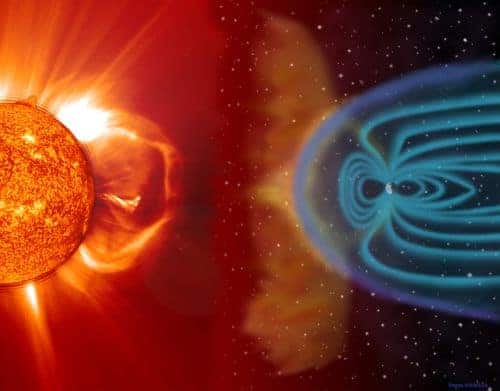
The idea of shielding spacecraft from harmful cosmic radiation using artificially-generated magnetic fields was once dismissed as unrealistically expensive. But new experiments carried out in the UK show that the technology could be made compact enough, and therefore cheap enough, to protect astronauts on flights to the Moon and Mars.
The existence of harmful radiation in space is one of the most significant obstacles to long-range spaceflight. Some of this is in the form of very high energy particles arriving from deep space, but the greater concern, by virtue of its much larger flux, is the solar wind emitted continuously by the Sun. This magnetized plasma contains protons and alpha particles (together with their disassociated electrons) that can break up DNA and cause cancer.
Astronauts travelling to the International Space Station are protected from much of this radiation by the Earth’s atmosphere as well as by its “magnetosphere”, the magnetized bubble of plasma surrounding the Earth created by its magnetic field. However, people on longer flights will not have this natural shielding and are therefore at greater risk. Indeed, it is reckoned that the astronauts of the Apollo programme escaped the particularly dangerous peaks in solar activity largely through luck.
Getting in a tin can with a rocket on your back and flying to Mars is never going to be a safe thing to do Ruth Bamford, Rutherford lab
Protective bubble
A team of physicists from the UK, Portugal and Sweden led by Ruth Bamford of the Rutherford lab has shown that it should be possible to shield spacecraft using artificial magnetospheres. Like the real thing, these would separate out the electrons and protons of the solar wind, generating a separation of charge in space that would deflect these particles away from the spacecraft. This idea was first put forward in the 1960s, but was considered unworkable because it was reckoned that a volume of space more than 100 km across would have to be shielded. Extending a field over this distance would require magnets with strengths of tens or even hundreds of Teslas, which could not be transported into space.
However, according to Bamford, these previous calculations are inaccurate because they assume that the solar-wind plasma flows like a normal fluid. Decades of research on nuclear fusion have instead shown that plasmas are subject to all sorts of turbulent behaviour not seen in normal fluids, and that, furthermore, this turbulence can occur on roughly human scales.
The researchers believe it is possible to exploit this knowledge of turbulence to create a much smaller protective bubble, and have confirmed this belief — first through computer simulations, and then in a laboratory experiment. The latter involved injecting a supersonic plasma into a 1.5 m long vacuum vessel lined with magnetic coils, with a target magnet placed at the far end of the vessel. Using both optical imaging and an electromagnetic probe, Bamford’s team showed that the target magnet deflected the plasma such that the volume of space surrounding the magnet was almost entirely free of plasma particles (Plasma Phys. Control. Fusion 50 124025).
More work
Bamford and colleagues say these results show that a spacecraft could in fact be protected using a bubble just some 100–200 m across. This, they say, would correspond to a magnet of about 1 Tesla, which would be light enough to be transported into space.
Bamford told physicsworld.com that more work needs to be done in scaling the technique up before it can be tested aboard a satellite, but reckons that it could be perfected in time for a return to the Moon in around 2020. She does point out, however, that even if the technology works it will not provide complete protection. For one thing, it could not shield astronauts against very high energy intergalactic cosmic rays. “Getting in a tin can with a rocket on your back and flying to Mars is never going to be a safe thing to do,” she says.



